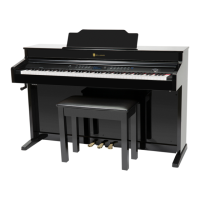
Do you have a question about the Williams OVERTURE III and is the answer not in the manual?
| Type | Digital Piano |
|---|---|
| Number of Keys | 88 |
| Effects | Reverb, Chorus |
| Connectivity | USB, MIDI, Headphone Jack |
| Included Accessories | Power Adapter, Sustain Pedal |
Essential safety guidelines for operating the digital piano.
Regulatory compliance details for the digital piano.
Attaching cylindrical nuts and feet to the stand legs.
Securing piano base to legs and attaching support brackets.
Attaching modesty panel and placing piano section onto stand.
Attaching headphone hook and connecting cables.
Detailed instructions for assembling the piano bench.
Overview of piano features and initial setup guidance.
Guidelines for maintenance, physical handling, and transportation.
Recommendations for cleaning the piano and optimal placement locations.
Advice on power usage, electrical safety, and environmental conditions.
Operating power, volume, song playback, and track recording.
Utilizing USB playback, metronome, and demo song features.
Using advanced functions like Song Tutor and keyboard transposition.
Understanding the display and using the value dial for navigation.
Selecting instrument voices and activating Chorus/Mod FX.
Configuring split keyboard and duet play modes.
Understanding connectivity status indicators.
Details on pedal input, audio outputs, power input, and headphones.
Information on USB and auxiliary audio inputs.
Understanding the LCD screen and front panel buttons.
How to power on the piano and manage auto power off.
Selecting and layering different instrument sounds.
Adjusting metronome tempo, time signature, and volume.
Transposing the keyboard pitch by semitones.
Shifting the keyboard's octave range up or down.
Combining two voices to create layered sounds.
Dividing the keyboard into two sections with different voices.
Enabling duet mode for two players.
Instructions for recording performances on the piano.
Playing demo songs and adjusting global tuning.
How to change reverb type and depth.
How to change chorus type and depth.
Selecting Mod FX types and configuring rotary speed.
Adjusting vibrato/tremolo speed and depth.
Configuring auto power off and power saving features.
Performing a factory reset and adjusting velocity curves.
Using the song tutor to learn songs with part muting.
Connecting devices wirelessly for audio and MIDI via Bluetooth.
Loading and playing MIDI files from a USB drive.
Understanding MIDI basics and disabling internal sound for MIDI control.
Using multitimbral mode and setting MIDI channels for multi-part playback.
Troubleshooting MIDI issues and understanding memory autosave.
Details on keyboard type, voices, polyphony, and pedal functions.
Information on demo songs, MIDI settings, I/O connectors, and speakers.
Specifications for physical dimensions, weight, and included accessories.
Details of the one-year limited warranty for parts and labor.
Instructions on how to register the product for warranty.